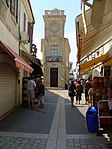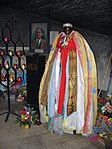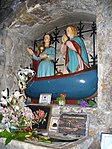Saintes-Maries-de-la-Mer
| Saintes-Maries-de-la-Mer | ||
|---|---|---|

|
|
|
| region | Provence-Alpes-Cote d'Azur | |
| Department | Bouches-du-Rhône | |
| Arrondissement | Arles | |
| Canton | Arles | |
| Community association | Arles-Crau-Camargue-Montagnette | |
| Coordinates | 43 ° 27 ' N , 4 ° 26' E | |
| height | 0-6 m | |
| surface | 374.61 km 2 | |
| Residents | 2,330 (January 1, 2017) | |
| Population density | 6 inhabitants / km 2 | |
| Post Code | 13460 | |
| INSEE code | 13096 | |
| Website | lessaintesmaries.fr | |
 Saintes-Maries-de-la-Mer |
||
(Les) Saintes-Maries-de-la-Mer is a municipality with 2330 inhabitants (as of January 1, 2017) in the French department of Bouches-du-Rhône , part of the Provence-Alpes-Côte d'Azur region . Saintes-Maries-de-la-Mer is the westernmost municipality of the Bouches-du-Rhône department. Since the municipality has extensive nature reserves at the mouth of the Rhone, it has an area of 374.6 km², an extremely low population density, even by French standards . It is located in the Camargue Regional Nature Park . This place in the Camargue countryside is an old place of pilgrimage that is today strongly influenced by tourism .
history
Saintes-Maries (the short form) was first mentioned as Sancta Maria de Ratis in the 4th century . Césaire of Arles bequeathed this settlement to a monastery in his will in 542; thereafter the place was called Saintes Maries (or Notre-Dame ) de la Barque . In 859/860 Vikings went on one of their forays from here up the Rhone to the area of Valence . In 869 the Saracens also used this area as a gateway for their sacking of Arles .
In the 14th century was the Notre-Dame-de-la-Mer on the fortified church rebuilt, which still stands today, and since that time the name was Notre-Dame-de-la-Mer in use. In 1448 (alleged) relics of the two saints Maria Cleophae and Maria Salome were discovered , which subsequently led to a special " Marian cult ", to which believers also made pilgrimages from further afield. During the French Revolution this cult was banned and the church was partially destroyed (restored in 1873).
In 1838 the city took its current name. In 1924 the French artist Hermann-Paul developed the Camargue Cross there .
Two pilgrimages have taken place every year to this day: the pilgrimage to Saintes-Maries-de-la-Mer on May 24th and 25th - this also in honor of the black Sara as the patron saint of the Gitans (these are mainly Roma of Spanish origin ) - and at the end of October every year again in honor of Marys Cleophae and Salome.
Population development
| year | 1962 | 1968 | 1975 | 1982 | 1990 | 1999 | 2007 | 2016 |
| Residents | 2179 | 2244 | 2120 | 2045 | 2232 | 2479 | 2317 | 2504 |
| Sources: Cassini and INSEE | ||||||||
Development in the 20th century
In the 1950s / 1960s, Les Saintes-Maries-de-la-Mer became an insider tip for the French new “Bohème” , and soon also for the European beatniks , and it remained a religiously important place for the Gitanes ; On some summer nights, a spontaneous flamenco festival developed on the streets and on the Mediterranean beach.
As is often the case with insider tips, the city grew from 680 to around 2500 inhabitants between 1960 and 1999, and during the summer months it is home to many times that number. In the meantime, practically no one works there as a fisherman or farmer; the residents live from tourism. Saintes-Maries-de-la-Mer is currently experiencing a further expansion of the relevant infrastructure, which is permanently changing the original face of the city (construction of apartment complexes, a sports boat harbor, planning a high-speed course for windsurfers, etc.). A 25 km long footpath leads through the nature reserve east of the village to the neighboring Salin-de-Giraud .
Personalities related to the place
- Vincent van Gogh (1853–1890), Dutch painter and draftsman, was in Saintes-Maries-de-la-Mer in May 1888, where he made the sketches for the later painting Fishing Boats on the Beach of Les Saintes-Maries.
- Marquis Folco de Baroncelli-Javon (1869–1943), French writer and rancher. As an influential Gardian , he is an important figure in the traditional Camargue way of life and culture in southern France. Les Saintes-Maries-de-la-Mer honors Folco de Baroncelli-Javon with a museum.
Town twinning
Saintes-Maries-de-la-Mer has a partnership with the Italian city of Grosseto in Tuscany and the Spanish Villamanrique de la Condesa in Andalusia .
Web links
- Saintes-Maries-de-la-Mer, history - info
- Saintes-Maries-de-la-Mer - Website of the Tourist Office (French)
- Saintes-Maries-de-la-Mer - Shrine of Saint Sara la Kali (English)
Individual evidence
- ↑ Thomas Noll, Vincent van Gogh - Fishing Boats on the Beach of Les-Saintes-Maries-de-la-Mer, Insel Verlag 1996, ISBN 9783458335061
- ↑ afccre - Annuaire des villes jumelées









